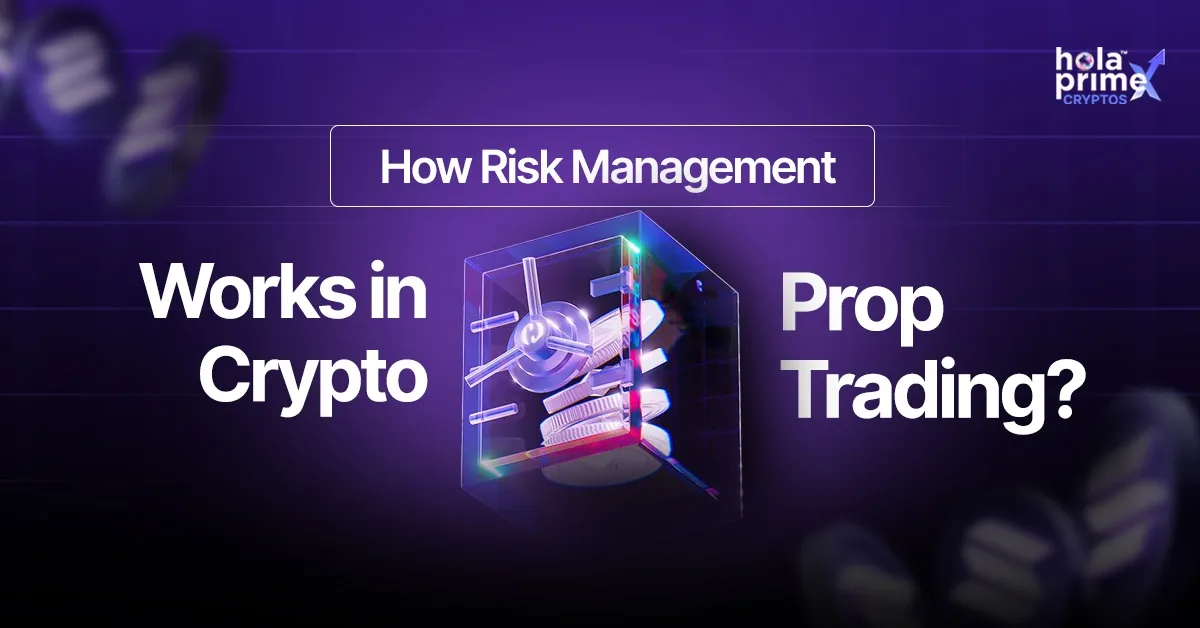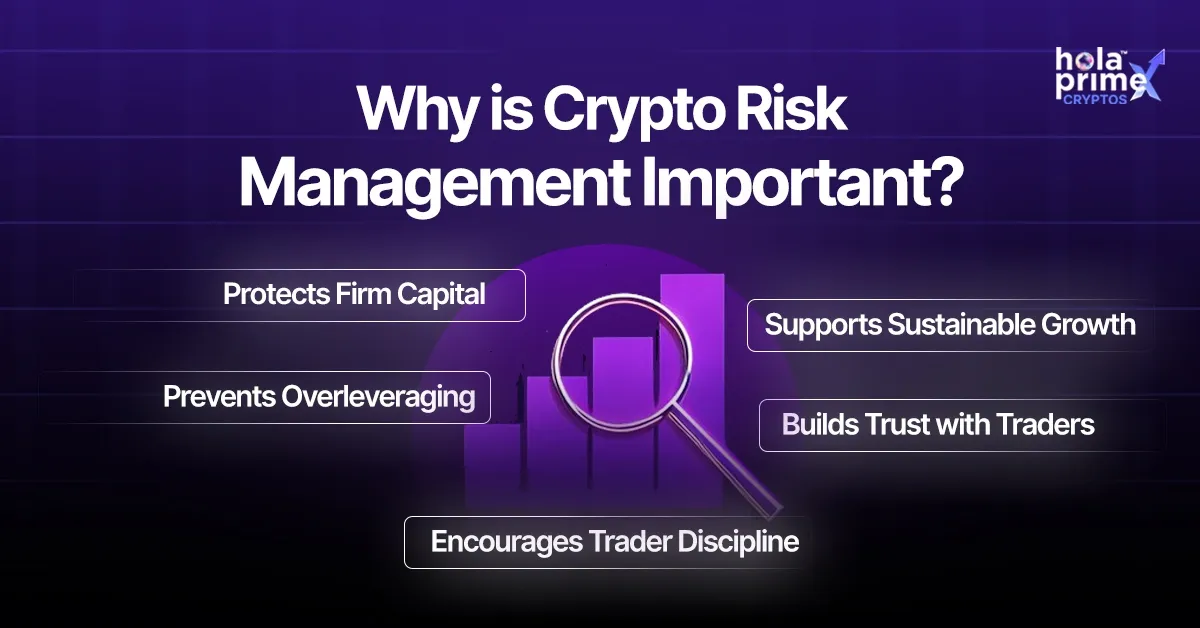Upto 70% OFF on $5K to $100K Challenges
Use Code: HOLA70
Get 60% OFF on $50K Challenges
Use Code: TRADEFEST60
Get 70% OFF on $5K-$25K Challenge
Use Code: TRADEFEST70
Get 30% OFF on $5K to $100K Direct Accounts
Use Code: TRADEFEST30
Get 25% OFF with
Code: WELCOME25
on $5K to $100K Challenges

Crypto prop trading is an exhilarating endeavor! Traders are able to earn huge profits using their trading strategies and the company’s capital. But with great capital comes great responsibility and that’s where crypto risk management comes into the picture. Without risk management, even traders with great skills and knowledge can find themselves taking huge losses. So, how do crypto prop firms manage risk while still being able to be profitable in volatile markets? Let’s take a look.

Since traders trade with the company’s funds, capital needs to be protected. One poor trade can result in significant losses if risk management is not done properly. By establishing rules, crypto prop firms guarantee that their capital is protected even in the face of extremely volatile markets or bad trading decisions.
Crypto risk management keeps traders from making rash decisions by putting in place a framework. When there are rules in place, traders are more likely to follow them. This promotes consistency and discipline, two traits necessary for long-term trading success, especially in the erratic and quick-paced cryptocurrency markets.
A high level of leverage can either lead to large profits or catastrophic losses. Crypto risk management will limit use of leverage to protect the trader and the firm. If traders do not have the ability to overleverage, then they can avoid blowups from changes in price and liquidation events that occur on a regular basis in the crypto markets.
Firms want traders to grow steadily, not burn out quickly. Risk rules ensure that traders scale gradually as they prove themselves. With controlled risk, traders develop experience, grow their accounts over time, and avoid the mistakes that come with rapid gains followed by sharp losses.
Traders are more confident when they know the system is fair and structured. Transparent risk policies create a mutual understanding. Firms know traders won’t act recklessly, and traders know what is expected. This trust leads to better cooperation and a more professional trading environment for everyone involved.
Traders receive a fixed amount of capital based on experience or evaluations. This limit controls exposure and prevents emotional overtrading. Capital preservation in crypto trading forces traders to think strategically and use resources wisely. Smaller allocations at the beginning help firms assess risk appetite and trading behavior before increasing access to larger capital amounts based on performance and consistency.
Drawdown rules restrict the dollar amount that can be lost by a trader per day or as a total. For example, a daily drawdown might be 5% and a total drawdown might be 10%. If a trader goes beyond these limits, they can be suspended or have their accounts reset. Drawdown management in crypto trading is in place to protect both the firm and the trader from terrible losses because of bad decision-making and volatile market conditions.
Position sizing assists in avoiding taking on too much risk in a single trade. Firms demand that traders determine trade size by taking market volatility and account equity into account. This promotes risk-adjusted performance, limits exposure, and guarantees consistency. To manage the possibility of loss on each position, traders are advised to employ set percentages or lot sizes per trade.
Prop firms have limits on the leverage traders can take. Sometimes it is capped at 5x or 10x depending on the asset class. This prevents accounts from being wiped out by small market shifts that happen all the time. Limits on leverage enable traders to be more responsible with their trades and encourage traders to take setups with good conviction and a proper risk-reward ratio.
Traders must maintain minimum risk-to-reward ratios, which are usually 1:2 or greater. This implies that the possible profit should be at least two dollars for every dollar risked. It guarantees that overall profitability can be achieved even with a lower win rate. Additionally, it encourages selective trading with high-quality setups as opposed to low-probability or impulsive trades.
Stop-loss orders are mandatory in most crypto prop firms. The crypto trading stop-loss strategy ensures each trade has a maximum acceptable loss defined in advance. This protects your capital, enhances your discipline, and helps avoid emotional decisions if markets move quickly or randomly against your open trading positions.
Firms conduct regular audits of trading activity, usually on a daily or weekly basis. These reviews check for behavior such as revenge trading, long holding durations, overexposure, or breaching rules. This helps catch early warning signs of poor risk behavior and ensures that traders are operating within the agreed guidelines and safety measures.
Real-time account monitoring is possible with sophisticated trading dashboards. They monitor metrics such as daily loss and maximum loss. The system has the ability to notify risk managers or automatically close positions if a trader breaks the rules.
Traders are assessed on more than just profits. Firms evaluate metrics such as consistency rules, maximum drawdown, average risk per trade, win rate, and trade duration. These statistics reveal how well traders manage risk over time. High scores in risk discipline and trade consistency often lead to scaling opportunities and increased capital access for top performers.
Even profitable traders must prove they can manage risk before receiving more capital. Scaling is tied to consistent performance and adherence to rules. Traders who maintain discipline over time and demonstrate low drawdowns are rewarded with increased account sizes or better profit splits. This ensures only responsible and stable trading behavior gets rewarded with growth.
Crypto prop trading firms build capital-protecting, structured systems. These systems are intended to prevent needless losses while directing traders to adhere to consistent rules. Performance, protection, and long-term trading sustainability for all parties are the main priorities.
To enforce risk controls, prop firms use real-time dashboards and sophisticated platforms. When necessary, these tools notify managers, automatically monitor trades, and close violating positions. The system helps shield the firm’s capital from significant harm, even in the event that a trader becomes impetuous or irresponsible.
Prop firms also teach traders how to manage risk. They provide instruction on proper trade size, leverage management, and stop-loss setting. This training aids traders in refining their tactics and forming routines that promote their personal development as well as the success of the company as a whole.
Risk management in crypto prop trading is a critical foundation for long-term and sustainable success. In many cases prop trading firms rely on an infrastructure built on automation, a strict evaluation of risk, leverage controls and a drawdown limit in order to protect the capital they have and the performance of their traders. Crypto prop firms help maintain profitability by creating and implementing structured risk management systems that guard against significant losses, promote self-control, and foster long-term growth for both the company and its traders.
Crypto risk management refers to the systems and rules prop firms use to protect capital and control trader behavior in volatile crypto markets.
Drawdown limits prevent traders from losing too much in a day or overall, protecting both firm and trader from major losses.
Stop-loss orders limit potential losses by closing trades automatically at a predefined level. They protect both the trader’s and the firm’s capital from big downturns.
Risk management tools like stop-losses, capital limits, and automated monitors help limit the damage quickly.
Yes, many offer dashboards, risk calculators, and real-time metrics to help traders stay within rules. Some platforms even block trades that violate risk parameters.
Disclaimer: All information provided on this site is for educational purposes only, related to trading in financial markets. It is not intended as financial advice, business or investment recommendation, or as an opportunity or recommendation to trade any investment instruments. Hola Prime only provides an educational environment to traders, including tools, materials and simulated trading platforms which have data feed provided by Liquidity Providers. The information on this site is not directed at residents in any country or jurisdiction where such distribution or use would be contrary to local laws or regulations.
Trade Fest is Live
Up To 70% Off
Get Started for just
$15